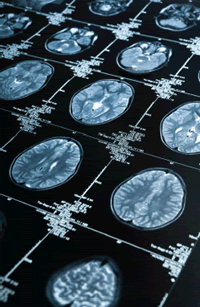The Alzheimer’s Brain
- By Linda Kossoff
- Nov 01, 2009
The results of autopsies over the course of many years have helped scientists recognize certain abnormal changes in the brain that coincide with the onset and progression of Alzheimer’s disease (AD). Such changes include the buildup of protein fragments called amyloid plaques between brain nerve cells and the collapse of neurofibrillary tangles inside those cells. As the disease progresses, brain tissue shrinks and the chambers that contain cerebrospinal fluid become enlarged. Degeneration becomes apparent as the disease spreads to different areas of the brain, affecting short-term memory, judgment, language, mood, behavior and, ultimately, long-term memory, including the ability to speak, recognize people and control bodily functions.
 In addition to the standard lab tests and neurological assessments used to identify AD, brain imaging (scanning) techniques have proven useful in reaching a diagnosis, or finding evidence—such as blood clots, bleeding or tumors—of other problems causing neurological dysfunction. These techniques include:
In addition to the standard lab tests and neurological assessments used to identify AD, brain imaging (scanning) techniques have proven useful in reaching a diagnosis, or finding evidence—such as blood clots, bleeding or tumors—of other problems causing neurological dysfunction. These techniques include:
Magnetic resonance imaging (MRI) – Radio waves and a strong magnetic field help to produce detailed images of the brain (shown at right).
Computerized tomography (CT) – X-rays pass through the body from various angles and the information obtained is processed by a computer to create cross-sectional “slices” of the brain.
Positron emission tomography (PET) – Radioactive material is injected into the patient and binds to chemicals that travel to the brain. An overhead scanner tracks the material to show which parts of the brain are not functioning as they should. This test is particularly useful for diagnosing Alzheimer’s disease because it can reveal levels of brain activity of plaque density.
Although there is no way to absolutely prove the presence of Alzheimer’s disease in a living human being, certain procedures, including brain imaging tests, help doctors to arrive at a conclusion regarding the presence of the disease.
Source: Mayo Clinic
This article originally appeared in the Respiratory & Sleep Management November 2009 issue of HME Business.
About the Author
Linda Kossoff is a writer/editor with 20 years of experience in the health, beauty, entertainment and education arenas. She is a former editor of Respiratory & Sleep Management magazine.